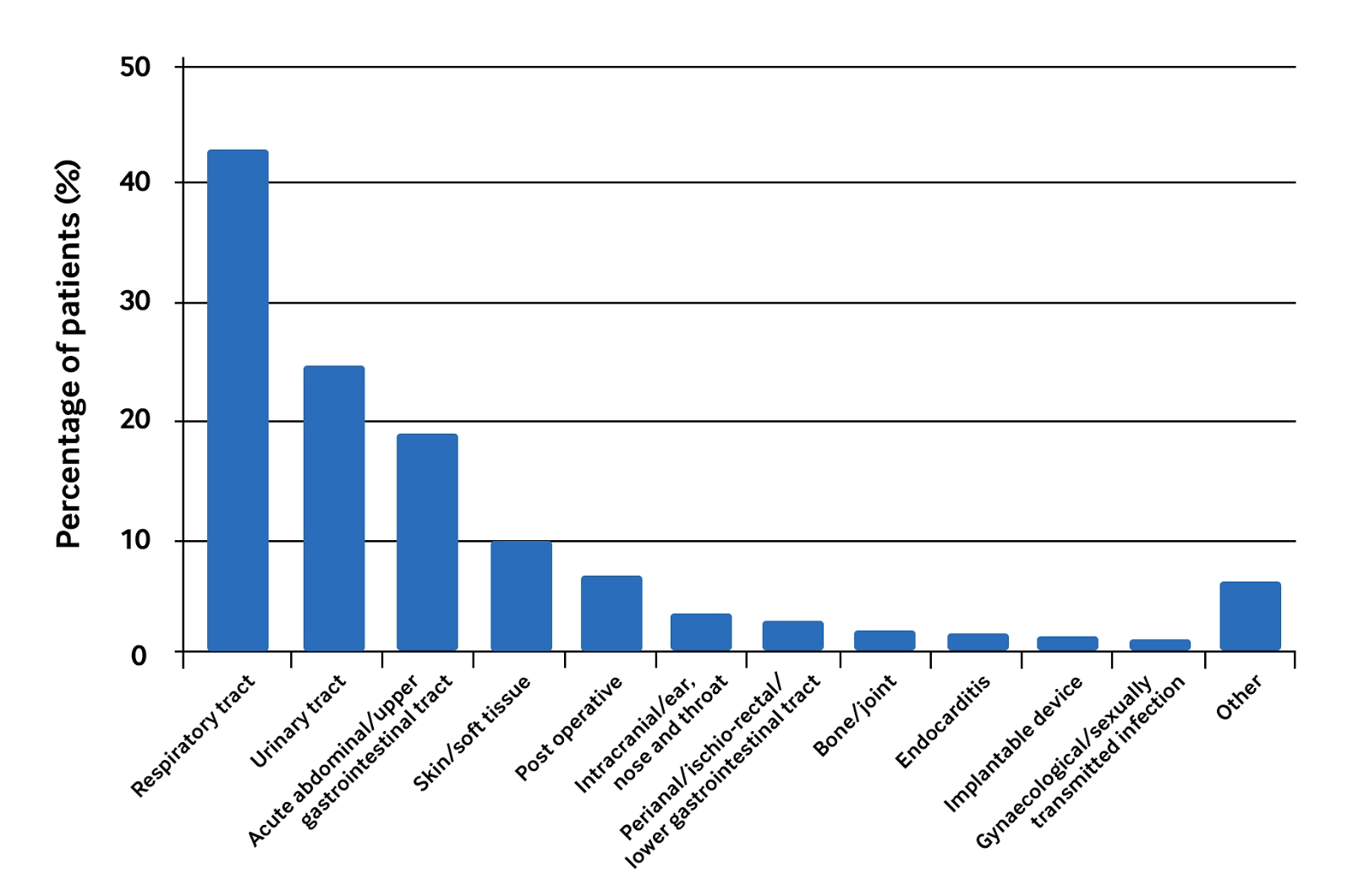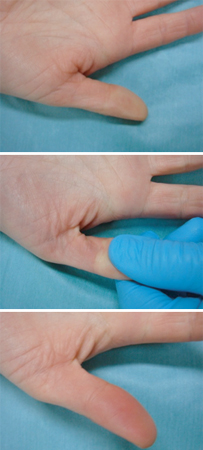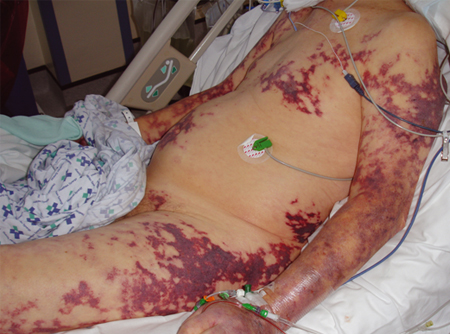History and exam
Key diagnostic factors
common
risk factors
Have a higher index of suspicion for sepsis when a patient presents with signs of infection and acute illness and falls into an at-risk group:
Age older than 65 years (and particularly older than 75 years)[3][9][36][52]
Immunocompromised (e.g., chemotherapy, sickle cell disease, AIDS, splenectomy, long-term steroids)[3][36][37][53][54]
Suspect neutropenic sepsis in patients who have become unwell and (a) are having or have had systemic anticancer treatment within the last 30 days or (b) are receiving or have received immunosuppressant treatment for reasons unrelated to cancer.[3]
Indwelling lines or catheters[3]
Recent surgery (in previous 6 weeks).[3] The risk of sepsis is particularly high following oesophageal, pancreatic, or elective gastric surgery[38]
Haemodialysis[36]
Diabetes mellitus[36]
Intravenous drug misuse[3]
Pregnancy (and the 6 weeks after delivery/termination/miscarriage)[3]
Breaches of skin integrity (e.g., burns, cuts, blisters, skin infections).[3]
Age younger than 1 year is also a strong risk factor.[3] See Sepsis in children.
Be aware of the risk of sepsis in women who are pregnant, have given birth, or have had a termination or miscarriage in the past 6 weeks. Risk factors for the development of sepsis in these groups include:[3][63]
Obesity
Gestational diabetes or diabetes mellitus
Impaired immune systems (due to illness or drugs)
Anaemia
History of pelvic infection
History of group B streptococcal infection
Amniocentesis and other invasive procedures (e.g., instrumental delivery, caesarean section, removal or retained products of conception)
Cervical cerclage
Prolonged rupture of membranes
Vaginal trauma
Wound haematoma
Close contact with people with group A streptococcal infection (e.g., scarlet fever).
Practical tip
When weighing up whether a patient who is acutely ill with symptoms or signs of possible infection can be safely managed in the community, it is important to consider whether they fall into one or more of the at-risk groups.[3]
Practical tip
Pay particular attention to the patient’s family/carers when taking a history. They will know the patient well and might be able to offer insight into acute behavioural changes as well as changes to their respiration or circulation, compared with the norm. Consider how they may describe the result of changes in physiology that are likely to have affected the patient’s vital observations, for example:[62]
Altered mental state – ‘confused’, ‘drowsy’, ‘not themselves’
Fever – ‘warm to touch’, ‘shivery', ‘burning up’
Hypotension – ‘dizzy’, ‘faint’, ‘lightheaded’
Tachypnoeic – ‘out of breath’, ‘breathless’
Tachycardic – ‘heart is racing’, ‘heart is pounding’.
signs associated with specific source of infection
The most common sources of infection are:[61]
Respiratory tract (cough/pleuritic chest pain)
Urinary tract (flank pain/dysuria)
Abdominal/upper gastrointestinaI tract (abdominal pain)
Skin/soft tissue (abscess/wound/catheter site)
Surgical site or line/drain site.
Signs and symptoms of possible infection sources Opens in new window
Use the history to identify factors for acquiring infection and clues to infection sites to guide choice of antimicrobial therapy.[21]
Ask specific questions, including:
When was the last time you passed urine?
And how often over the past 18 hours?[3]
Do you take any medication?
Have you recently taken antibiotics?
Have you recently seen your general practitioner (GP) or been in hospital and/or had surgical procedures?
Have you travelled abroad recently?
Have you had contact with animals?
Have you had any contact with anyone infectious?
Ask about the patient’s lifestyle, including:
Drug misuse
Alcohol intake
Housing situation.
Practical tip
Pay particular attention to the patient’s family/carers when taking a history. They will know the patient well and might be able to offer insight into acute behavioural changes as well as changes to their respiration or circulation, compared with the norm. Consider how they may describe the result of changes in physiology that are likely to have affected the patient’s vital observations, for example:[62]
Altered mental state – ‘confused’, ‘drowsy’, ‘not themselves’
Fever – ‘warm to touch’, ‘shivery', ‘burning up’
Hypotension – ‘dizzy’, ‘faint’, ‘lightheaded’
Tachypnoeic – ‘out of breath’, ‘breathless’
Tachycardic – ‘heart is racing’, ‘heart is pounding’.
Practical tip
Check to see whether there are any microbiological samples already in the lab (e.g., urine sent by the GP) or other available test results (bloods, x-rays etc).
Evidence: Infectious causes of sepsis
The Extended Prevalence of Infection in Intensive Care (EPIC II) study provides the best recent evidence on the infectious causes of sepsis in an intensive care setting.[20]
The study gathered extensive data from more than 14,000 adult patients in 1265 intensive care units from 75 countries on a single day in May 2007.
Of the 7000 patients classified as ‘infected’, the sites of infection were the:
Lungs: 64%
Abdomen: 20%
Bloodstream: 15%
Renal or genitourinary tract: 14%.
Of the 70% of infected patients with positive microbiology:
47% of isolates were gram-positive ( Staphylococcus aureus alone accounted for 20%)
62% were gram-negative (20% Pseudomonas species and 16% Escherichia coli)
19% were fungal.
Other studies tend to broadly concur on the relative frequencies of sources of infection. The graph below shows the results of the National Confidential Enquiry into Patient Outcome and Death (NCEPOD) report in 2015.[61][Figure caption and citation for the preceding image starts]: The relative frequencies of sources of infection in sepsisCreated by the BMJ Knowledge Centre; based on 'NCEPOD. Just say sepsis! Nov 2015' [Citation ends].
Evidence from studies in people over age 65 years shows the genitourinary tract is the biggest source of infection.[21][22]
high early warning score (e.g., NEWS2 5 or more)
Early identification of sepsis relies on systematic assessment of any acutely ill patient who presents with presumed infection to identify their risk of deterioration due to sepsis. By the time sepsis is at an advanced stage, with multiple abnormal physiological parameters, the risk of mortality is very high.[41]
In any patient in whom sepsis is a possibility, use a systematic process to check vital observations and assess and record the risk of deterioration.[41][42][43] Remember that no risk stratification process is 100% sensitive or 100% specific; therefore, you must use your clinical judgement.
Consult local guidelines for the recommended approach for assessing acute deterioration.
In hospital: use the National Early Warning Score 2 (NEWS2) or an alternative early warning score.[41][42][44] NEWS2 is endorsed by NHS England and the National Institute for Health and Care Excellence (NICE) for use in this setting.[3][41]
NICE recommends to use NICE high-risk criteria for stratification of risk (rather than NEWS2) in an acute setting in patients who are or have recently been pregnant.[3]
In the community and in custodial settings: use an early warning score such as NEWS2, which is recommended by NHS England and supported by the Royal College of General Practitioners in the UK.[41][51] An alternative in the UK is to use NICE high-risk criteria.[3]
None is validated in primary care.[51]
NEWS2 is the most widely used early warning score in the UK National Health Service and is endorsed by NHS England and NICE.[3][41] NHS England: Sepsis Opens in new window In a patient with a known or likely infection, a NEWS2 score of 5 or more is likely to indicate sepsis.[42]
Arrange urgent assessment by a senior clinical decision-maker (e.g., ST3 level doctor in the UK) for any patient with an aggregate NEWS2 score of 5 or more.[41]
The higher the resulting aggregate NEWS2 score, the higher the risk of clinical deterioration.[3][41][42]
Although a senior decision-maker should be involved and aware at an early stage for all patients at high risk of severe illness or death, review may be carried out by a clinician with core competencies in the care of acutely ill patients (FY2 level or above in the UK) to urgently assess the person's condition and think about alternative diagnoses to sepsis.[3]
If necessary (e.g., NEWS2 score of 7 or more, or no response within 1 hour of any intervention such as antibiotics/fluid resuscitation/oxygen), arrange emergency assessment by a critical care specialist.
Practical tip
It is important to be aware that no scoring system has been validated for use in pregnant women or women who have recently been pregnant (in the 24 hours following a termination of pregnancy or miscarriage for 4 weeks after giving birth); in practice, seek senior input to determine the best approach in these patients.
NICE recommends use of the NICE high-risk criteria for stratification of risk (instead of NEWS2) in an acute setting in patients who are or have recently been pregnant.[3]
Examples of scores that have been developed but are yet to be universally accepted include the following.
A modified qSOFA has been proposed by the Society of Obstetric Medicine Australia and New Zealand (SOMANZ) for use in pregnant women. The SOMANZ score includes systolic blood pressure 90 mmHg, respiratory rate >25 per minute, and altered mental status.[71]
The Sepsis in Obstetrics Score uses a combination of maternal temperature, blood pressure, heart rate, respiratory rate, peripheral oxygen saturation, white blood cell count, and lactic acid level as predictors of intensive care admission for sepsis.[72]
Alert a consultant to attend in person if a patient with suspected sepsis, who is or has recently been pregnant and meets any high-risk criteria, does not respond within 1 hour of any intervention.[3]
tachypnoea (NEWS2)
high or low temperature, sometimes with rigors (NEWS2)
Although changes in body temperature are often seen in people with sepsis, temperature should not be used as the sole predictor of sepsis and should not be used to rule sepsis either in or out. Be aware that some people with sepsis will present with a normal temperature.[3][41][42]
Practical tip
Never rule out sepsis on the basis of a normal temperature reading. Fever is a common presenting sign but some patients are apyrexial or have hypothermia.[3]
Always assess the patient’s temperature in the context of their wider clinical picture.
Hypothermia at presentation is associated with a poorer prognosis than fever.[64]
People who are older (>75 years) or very frail (regardless of age) are particularly prone to a blunted febrile response and may present with a normal temperature.[3][65]
Patients with a spinal cord injury may not develop a raised temperature.[3]
Other groups that are less susceptible to temperature fluctuations and so may not develop a raised temperature with sepsis include:[3]
Infants or children
People with cancer receiving treatment
Severely ill patients.
tachycardia (NEWS2)
A common feature of sepsis;[21][43] typically heart rate >90 beats per minute (bpm).
Practical tip
Always interpret the vital signs that you take as part of the Airway, Breathing, Circulation, Disability, Exposure (ABCDE) assessment in relation to the patient’s known or likely baseline for that parameter; take account of the patient in front of you and the full clinical picture. For example:
A fall in systolic blood pressure of ≥40 mmHg from the patient’s baseline is a cause for concern, regardless of the systolic blood pressure reading itself[3]
Although tachycardia can be an indicator of potential risk of sepsis developing, when assessing heart rate you should consider:[3]
Pregnancy
In pregnant women, heart rate is usually 10 to 15 bpm faster than normal
Older people
Older people may not develop tachycardia in response to infection and are more at risk of developing new arrhythmias (e.g., atrial fibrillation)
Medications
Some drugs, such as beta-blockers or rate-limiting calcium-channel blockers, may inhibit a tachycardic response to infection
Baseline
The baseline heart rate in young people or people who are very physically fit (e.g., athletes) may be lower than the norm. The rate of change of heart rate may therefore be more important (to reflect the severity of infection) than the actual rate.
acutely altered mental status (NEWS2)
Determine the patient’s baseline mental state and establish whether there has been a change.[3] Use a validated scale (e.g., the Glasgow Coma Scale or AVPU ['Alert, responds to Voice, responds to Pain, Unresponsive'] scale). [ Glasgow Coma Scale Opens in new window ] [3] As well as checking response to cues, you should ask a relative or carer (if available) about the patient’s recent behaviour.[3]
Practical tip
Change in mental state is a commonly missed sign of sepsis, particularly in older patients in whom dementia may co-exist. Change in mental state is often due to non-infectious causes (e.g., electrolyte disturbances). It can manifest in many ways, which makes it challenging to recognise as part of a short clinical consultation.
The term ‘confusion’ can be unhelpful and instead you should attempt to identify any change from the patient’s normal behaviour or cognitive state.[3]
A collateral history – if friends, family members, or carers are available – is key. They might describe the patient as ‘not themselves’.
In people with dementia or learning disability, change in mental state may present as irritability or aggression, but in dementia, could also present with hypoactive delirium (e.g., with lethargy, apathy).[3][60]
In addition, sepsis may be signalled by a deterioration in functional ability (e.g., a patient newly unable to stand from sitting).[3]
low oxygen saturation (NEWS2)
Low oxygen saturation is often seen in people with sepsis: systolic blood pressure <90 mmHg, mean arterial pressure <65 mmHg, or reduction in systolic blood pressure >40 mmHg from baseline.[21][43]
Practical tip
Difficulty obtaining peripheral oxygen saturations may be a red flag for possible shock.[3]
Peripheral oxygen saturations can be difficult to measure in a patient with sepsis if the tissues are hypoperfused.
This may occur in the later stages of the condition, as earlier in the disease process the circulation is usually hyperdynamic.
Some conditions such as meningococcal sepsis can present early with poor peripheral perfusion. These patients often have profound myocardial depression on presentation. In others, there may be a hyperdynamic central circulation concurrent with poor peripheral perfusion and a subsequent uncoupling of blood flow.
You should have a high index of suspicion for shock if you are unable to measure oxygen saturations.
See Shock.
hypotension (NEWS2)
Hypotension is commonly seen in people with sepsis.[21][43]
Beware septic shock, a subtype of sepsis with a much higher mortality.[1][42]
Characterised by profound circulatory and metabolic abnormalities.
Presents with persistent hypotension and serum lactate >2 mmol/L (>18 mg/dL) despite adequate fluid resuscitation, with a need for vasopressors to maintain mean arterial pressure ≥65 mmHg.[1]
oliguria
Assess the patient’s urine output.[3][47]
Ask the patient or their carer about urine output over the previous 12 to 18 hours
Consider catheterising the patient on presentation if they are shocked, confused, oliguric, or critically unwell
Ensure arrangements are in place for urine output to be monitored once an hour.
A low urine output may suggest intravascular volume depletion and/or acute kidney injury and is therefore a marker of sepsis severity.[3]
A patient who has not passed urine in the previous 18 hours (or for catheterised patients passed less than 0.5 mL/kg of urine per hour) is at high risk of severe illness or death from sepsis.[3]
poor capillary refill, mottling of the skin, or ashen appearance
Signs of circulatory insufficiency are thought to indicate peripheral perfusion, with a longer capillary refill time suggesting reduced capillary perfusion.[125]
[Figure caption and citation for the preceding image starts]: Capillary refill time. Top image: normal skin tone; middle image: pressure applied for 5 seconds; bottom image: time to hyperaemia measuredFrom the collection of Ron Daniels, MB, ChB, FRCA; used with permission [Citation ends].
cyanosis
A common non-specific sign of sepsis.[21]
Other diagnostic factors
common
uncommon
purpura fulminans
A very late sign of possible organ dysfunction; may be seen on presentation.
[Figure caption and citation for the preceding image starts]: Severe purpura fulminans; classically associated with meningococcal sepsis but can occur with pneumococcal sepsisFrom the collection of Ron Daniels, MB, ChB, FRCA; used with permission [Citation ends].
ileus
A sign of possible organ dysfunction.
jaundice
A rare sign of organ dysfunction unless it is associated with a specific source of infection ( biliary sepsis).
Use of this content is subject to our disclaimer

